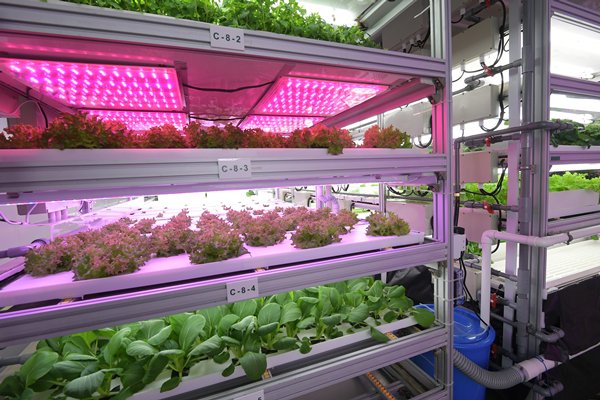New Tech Yields Bumper Crop

Growing nutritious vegetables faster through the use of technology instead of soil may sound like science fiction, but for the Agriculture, Fisheries & Conservation Department it is fast becoming science fact.
It has been proactively exploring different modernised production methods to enhance the development of Hong Kong’s agricultural industry and recently introduced two new technologies for hydroponic farming - changeable spectrum grow light technology and nanobubble technology, which can effectively speed up the growth of crops.
The two technologies were developed by the Nano & Advanced Materials Institute and have undergone trials at the Controlled Environment Hydroponic Research & Development Centre in Cheung Sha Wan.
Optimised growth
The changeable spectrum grow light technology works by enhancing the growth of vegetables through adjusting the spectrum to fit different growth stages of plants.
The department’s Agricultural Officer Chan Siu-lun explained that trial results showed with the support of the spectrum, the growth of red oak leaf lettuce sped up 20%, red coral lettuce 30%, while that of green oak leaf and green butterhead lettuce sped up by at least 50%.
“The nanobubble technology increases the amount of dissolved oxygen in water to improve the seed germination rate and growth rate.
“The seed germination rate of different vegetables increased by 3% to 36%, while the growth of vegetables also sped up significantly,” Mr Chan added.
Good harvest
Hydroponic farms chief executive officer Ray Lok set up one of his farms in a Tsuen Wan industrial building. The 900 sq ft facility uses the two technologies to grow vegetables.
Mr Lok noticed that by using the nanobubble technology to grow lettuce, the vegetables’ weight usually increased by 20% to 30%.
It was also more cost-effective than importing the technology from Japan.
“They are relatively affordable, they are cheap and they are locally developed so we have a lot of support from the Government. It has been quite useful so far.”
Farming future
The department hopes the two technologies can be widely used in agricultural production in the future.
“The two technologies can effectively speed up the growth rate of hydroponic vegetables. As a result, farmers enjoy a good harvest and higher quality vegetables can be supplied to the market for consumption,” said Mr Chan.
He noted that choosing a site for a hydroponic farm is more flexible as planting racks can be stacked vertically in layers for increased production while still maximising the amount of space needed to grow the produce.
By also using controlled environment technology, cultivation can be conducted indoors and ensure a steady supply throughout the year.
“The department will continue to promote the research and development of applied technology for hydroponic farming to diversify the production method for local vegetables. This can help boost the industry’s competitiveness and be conducive to its modernisation and sustainable development,” Mr Chan added.
Tours Showcase HK Brands
Imagine being able to step back in time to a 1950s grocery store where the product packaging is full of nostalgic char... Read more
Smart Training Aids Rehabilitation
Seventy-year-old Mr Lau has been experiencing difficulty walking ever since he suffered a stroke last year. After havi... Read more
Digging Deep To Overcome Obstacles
The Central Kowloon Bypass (Yau Ma Tei Section) is set to open on December 21, slashing the journey time from Yau Ma T... Read more
Adaptive System Optimises Traffic Flow
In a bustling city like Hong Kong, waiting for traffic lights to change to green is an inevitable part of life, especi... Read more
Drone Sports Add To Low-altitude Buzz
Alongside the Government’s push to develop Hong Kong’s low-altitude economy, drone sports have been gaining in pop... Read more
Construction Robots Enhance Efficiency
For the Trunk Road T2 & Cha Kwo Ling Tunnel project, the Civil Engineering & Development Department has applie... Read more

